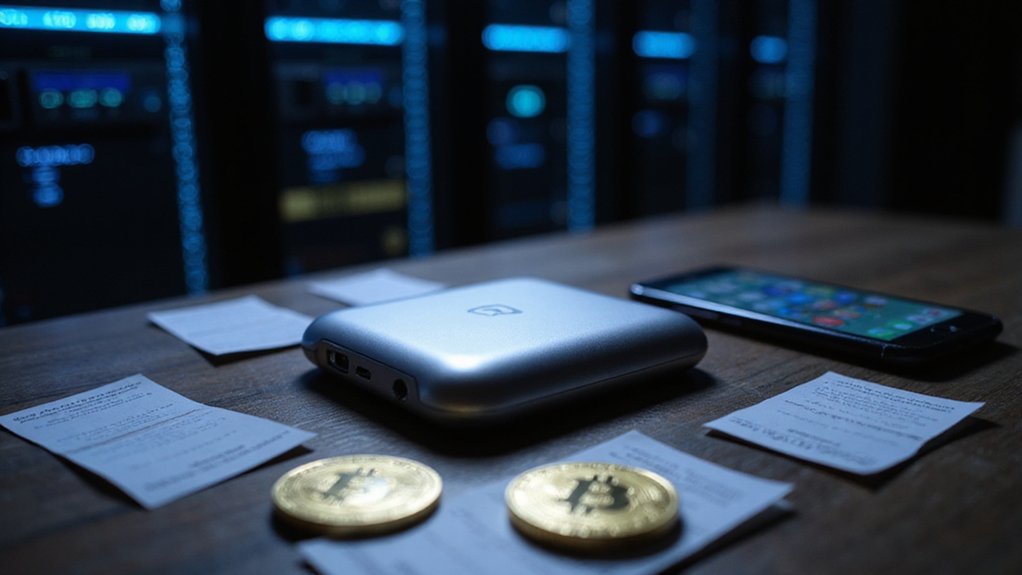Blockchain guarantees complete transparency by distributing identical transaction records across thousands of nodes simultaneously, creating what amounts to financial exhibitionism where concealment becomes structurally impossible. Cryptographic hashing links each block chronologically while consensus mechanisms demand majority validator agreement before ledger updates occur. Real-time visibility enables immediate anomaly detection, transforming opacity-loving traditional systems into open books where every transaction receives permanent, immutable documentation. The implications extend far beyond basic record-keeping into revolutionary territory.

The fundamental promise of blockchain technology—that distributed ledgers can eliminate the opacity plaguing traditional financial and commercial systems—rests on a deceptively simple proposition: when everyone can see everything, no one can hide anything.
This transparency emerges not from regulatory mandate or corporate goodwill, but from the structural impossibility of concealment within a distributed network where records exist simultaneously across thousands of nodes.
Unlike traditional ledgers maintained by single entities (who possess both the means and, regrettably, often the motive to manipulate entries), blockchain networks distribute identical copies of transaction histories to all participants.
Each transaction receives permanent chronological placement, creating an immutable sequence that would make Orwell’s Ministry of Truth weep with envy—except here, the past genuinely cannot be altered.
Cryptographic hashing links each block to its predecessor, ensuring that modifying historical data would require the practically impossible task of recalculating all subsequent blocks.
Real-time visibility transforms this transparency from theoretical concept to operational reality.
Authorized participants observe transactions as they occur, enabling immediate detection of anomalies that might otherwise fester unnoticed in traditional systems.
Public blockchains extend this visibility further, offering anyone the ability to scrutinize transaction flows—a level of openness that would horrify most CFOs if applied to conventional accounting.
The consensus mechanisms governing ledger updates provide the final transparency safeguard.
Changes require majority validator agreement through protocols like proof-of-work or proof-of-stake, preventing unilateral modifications that have historically enabled financial malfeasance.
Validators face economic incentives to maintain network integrity, creating a self-policing system where honesty becomes profitable necessity rather than moral choice.
This enhanced traceability creates unique digital fingerprints for assets and transactions, enabling stakeholders to verify authenticity and track provenance with unprecedented precision.
Supply chains benefit particularly from this capability, as the movement and custody of goods become permanently documented, reducing counterfeiting risks and fraud. The implementation of smart contracts enables automated verification and enforcement of contractual terms without requiring human intervention. These self-executing programs operate automatically when predefined conditions are met, further enhancing the transparency and reliability of blockchain transactions. Modern executives prioritize predicting supply chain risks, making blockchain’s transparent ledger particularly valuable for tracking critical components and detecting vulnerabilities before they disrupt operations.
For auditors and regulators, blockchain transparency offers thorough audit trails that simplify compliance reporting while reducing administrative costs.
The technology fundamentally transforms the traditional post-hoc audit into continuous, real-time verification—a shift that may render creative accounting as obsolete as the abacus.
Frequently Asked Questions
What Are the Main Drawbacks or Limitations of Blockchain Transparency?
Blockchain transparency faces several critical limitations that undermine its purported completeness.
Scalability constraints throttle transaction processing, while regulatory ambiguity creates jurisdictional inconsistencies. Technical complexity excludes non-experts from meaningful participation, and energy consumption raises environmental concerns.
Perhaps most ironically, the pseudonymous nature maintains user anonymity while selective data recording—excluding off-chain activities like labor practices—renders “complete” transparency rather incomplete, challenging the technology’s fundamental transparency premise.
How Much Does Implementing Blockchain Transparency Solutions Typically Cost?
Blockchain transparency implementations vary dramatically—from $5,000 basic applications to enterprise solutions exceeding $2 million.
Small enterprises typically budget $10,000-$70,000, while complex systems demand $200,000+.
Public blockchains offer lower initial costs but ongoing transaction fees; private networks require higher setup investments.
Regulated sectors face premium pricing due to compliance requirements.
Development phases include research, UI/UX design ($5,000-$40,000), development ($30,000-$200,000+), deployment, and perpetual maintenance—because transparency apparently comes with a price tag.
Can Blockchain Transparency Be Achieved Without Sacrificing User Privacy?
Blockchain networks can achieve substantial transparency while preserving user privacy through sophisticated cryptographic techniques like zero-knowledge proofs and confidential transactions.
These methods enable transaction verification without exposing sensitive details—amounts remain hidden while mathematical validity gets confirmed.
Selective disclosure protocols allow users to control information sharing selectively.
However, achieving this balance requires additional computational overhead and implementation complexity, making pure transparency seem almost quaint by comparison.
Which Industries Benefit Most From Blockchain’s Transparency Features?
Supply chain logistics and healthcare derive exceptional value from blockchain’s transparency features, given their complex multi-party ecosystems requiring immutable audit trails.
Financial services—somewhat ironically, considering the industry’s historical opacity—benefit substantially from transparent clearing and settlement processes.
Government operations gain credibility through transparent voting systems and public records management, though one might question whether complete transparency aligns with traditional bureaucratic preferences for selective disclosure.
How Long Does It Take to Implement Blockchain Transparency Systems?
Blockchain transparency implementation typically spans 4-12 months, depending on solution complexity and organizational readiness.
Simple applications (token issuance) deploy faster than intricate multi-party systems requiring extensive integration.
Highly regulated industries face extended timelines due to compliance requirements—because apparently adding KYC protocols to smart contracts wasn’t complicated enough already.
Teams with dedicated blockchain expertise accelerate deployment, while organizations blessed with modern IT infrastructure avoid the usual integration nightmares that plague legacy systems.









